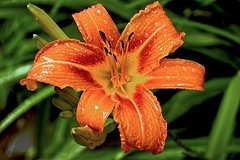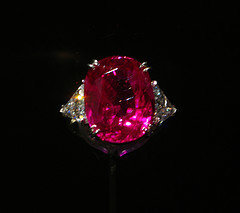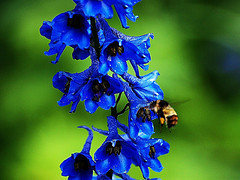





When you're a gardener, July means dealing with heat, humidity, weeds and bugs. Depending on the weather, you may spend a lot of time with a water hose in your hand. What pleasure, though, to perform your gardening tasks surrounded by lush flowers and ripening vegetables.
(Editor's Note: This article was originally published on July 11, 2011. Your comments are welcome, but please be aware that authors of previously published articles may not be able to respond to your questions.)
July garden favorites vary by horticultural zone, but many sunny perennial borders are showing off the blooms of hemerocallis, monarda, phlox, astilbe, liatris, veronica, hibiscus and sweet-scented Oriental lilies. Annuals such as petunias, geraniums, zinnias, marigolds and impatiens have hit their stride and overflow containers. In the shade, hostas grow fat and handsome, sending up the first of their white or lavender flower stalks. Vegetables get larger every day as they soak up the heat in northern gardens. In warmer climates, gardeners have been harvesting tomatoes, peppers and beans for weeks.
The Seventh Month
July ushers in the second half of the year and is on average the warmest month in the northern hemisphere. Originally, July was called Quintilis, or fifth, because of its placement in the order of the early Roman ten-month calendar. The month retained its name even after the addition of January and February meant that it became the seventh month. But upon Julius Caesar’s death in 44 BC, his birth month of Quintilis was renamed Julius -- in English, July -- in his honor.


 " Summer afternoon, summer afternoon; to me those have always been the two most beautiful words in the English language." ~ Henry James 1843-1916
" Summer afternoon, summer afternoon; to me those have always been the two most beautiful words in the English language." ~ Henry James 1843-1916 The Dog Days
July marks the beginning of the “dog days” of summer, which occur from July 3 to August 11, according to the Farmer’s Almanac. The name of this period of weather derives from the Latin “dies caniculares,” from the Latin term for the Canis Major constellation. This star grouping’s canine association derives from the ancient Egyptians. They named Sirius, its brightest star, to honor their god Osirus, whose hieroglyph resembled a dog. The Romans believed that when Sirius the "dog star" rose and set with the sun (which centuries ago occurred in midsummer), it created extra heat, so the twenty days preceding and following the conjunction were called the dog days. Blaming madness and numerous evils on the hot, sultry weather, the Romans even sacrificed a brown dog at the start of the dog days in an attempt to appease the rage of Sirius. Today we are more likely to associate the term “dog days” with the laziness that high temperatures elicit in canines and humans alike.

"Hot July brings cooling showers,
Apricots and gillyflowers."
~ Sara Coleridge

Independence Day
Although the Fourth of July, or Independence Day, did not become a paid federal holiday until well into the 20th century, Americans have been celebrating the day since the time of the American Revolution itself. It was actually the second day of July, 1776, when the Continental Congress voted in favor of a resolution for independence from Great Britain. That same day, John Adams wrote to his wife Abigail that July 2nd would “be celebrated, by succeeding Generations, as the great anniversary Festival,” recognized with “Pomp and Parade...Games, Sports, Guns, Bells, Bonfires and Illuminations from one End of this Continent to the other.” However, July 4th, the date on which Congress formally adopted the Declaration of Independence, became the commonly recognized day of celebration.
The first annual July 4 commemoration was held in Philadelphia in 1777, even as the Revolutionary War was being fought. General George Washington issued his troops double rations of rum on July 4, 1778. Early Americans continued to observe the day with speeches, concerts, parades, bonfires and the firing of cannons and muskets, along with readings of the Declaration of Independence itself. Although in modern times July 4th may have become more a summertime celebration than a political observance, the American flags on prominent display are a proud reminder of this day’s importance to our nation.

St. Swithun's Day
St Swithun's day if thou dost rain
For forty days it will remain
St Swithun's day if thou be fair
For forty days 'twill rain nae mare
This old English weather proverb, reflecting the common belief that the weather in mid-July would determine conditions for the next forty days, refers to Swithun (sometimes spelled Swithin), a 9th century bishop of Winchester whose feast day is celebrated on July 15. Legend states that upon his death in 852, Swithun requested that he be buried not in his cathedral, but in the churchyard where his humble grave would be subject to falling raindrops and the footsteps of passers-by. Although his burial wishes were initially followed, on July 15, 971, the monks of the cathedral decided to move Swithun’s remains into an elaborate shrine. According to tradition, a torrential downpour occurred that day, which the monks feared was an indication of the saint's displeasure. The connection of the mid-July date and weather prediction may actually pre-date the saint, stemming from an ancient pagan belief in prognostication on this day, according to Encyclopedia Britannica. Interestingly, there is some meteorological basis for the folklore, at least in western Europe. In midsummer, the jet stream generally settles into a holding pattern which determines the region’s weather for the coming weeks. The French have similar weather lore: “Quand il pleut a la Saint Gervais Il pleut quarante jours apres” -- rain on St. Gervais' day (July 19) means rain for forty days following. In Germany, June 27 (which actually would have fallen on July 7 prior to the Gregorian calendar reform) is Siebenschlaefer, or Seven Sleepers Day, a day thought to determine the weather for the next seven weeks.
July Symbols

Ruby
The ruby, July’s birthstone, takes its name from the Latin “ruber,” meaning red. Ruby is a type of corundum. Measuring 9.0 on the Mohs scale of mineral hardness, ruby is the second-hardest gemstone after the diamond. A ruby’s color can range from pink- or orange-red to purple-red, with the most valuable specimens being a true bright red. Rubies were prized by ancients who believed the gems bestowed good health upon the wearer and could warn a person of coming misfortunes by turning darker in color. In the Far East, the ruby was called the glowing stone or lamp stone because it was believed to be lit from within. Rubies are mined largely in Asia; in Burma, acknowledged as producer of the most beautiful of these gems, the rubies of the finest red color are called “pigeon’s blood.”
 Larkspur
Larkspur Water Lily
Water LilySources:
Curious About Astronomy? Ask An Astronomer: What Are the “Dog Days of Summer?”
Farmer’s Almanac: Dog Days Are Here!
History.com: July 4th
Encyclopaedia Britannica: “Saint Swithin’s Day”
Weather Online: St. Swithun’s Day
Graphics:
Gerber daisy by jimbrickett
Daylily by multi.phrenic
Veronica by chapstickaddict
Lily by beautifulcataya
Hosta by dibytes
Phlox by jsynn61
St. Svithun at Stavanger Cathedral by Nina Aldin Thune
July 4 postcard in the public domain
Ruby by thisisbossi
Larkspur by brucemckay
Water lily by urtica
Copyright © www.100flowers.win Botanic Garden All Rights Reserved